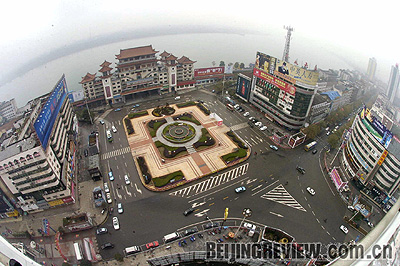|

SUSTAINABLE GROWTH: The resource-oriented central region has to focus on adjusting its industrial structure and cultivate sustainable growth in the coming future
Central China, which includes Shanxi, Henan, Anhui, Jiangxi, Hubei and Hunan provinces, is widely considered less developed than the prosperous eastern coastal region, the frontier of China's economic reform and opening up, but richer than the undeveloped and less populated vast western region.
But that's all story of the past. The central region has lagged behind the western region since China adopted a "west development" strategy in 2000 and gave priority to the west in policies and development funding allocation. The uneven development in different regions has taken the shape of "U" and the central region sunk toward the bottom.
Officials from the six central provinces gathered in Wuhan, capital of Hubei Province, to discuss issues on the central China rise on April 26. This is the third time they met each other for this purpose, with the previous two meetings held in Changsha, capital of Hunan, and Zhengzhou, capital of Henan, respectively. The sponsor of the event also invited representatives of domestic enterprises and multinationals and officials of the ministries and commissions of the Central Government in hopes of winning their support. The event this year drew overseas representatives of governments and corporations from 113 countries or regions, and nearly 60,000 businessmen nationwide.
It's a consensus among the six provinces that they must promote the economic growth of the central region altogether, said Wang Sanyun, Governor of Anhui Province, on April 26 at the Third Central China Investment and Trade Expo.
Opportunities in sight
The central region, with 28.1 percent of the country's total population, contributes to 20 percent of the country's GDP. Compared to east, northeast and west China, the central region is not a region with integrated economic functions. It's a geographical division. "It's probably because of this that the central region sees new opportunities in inheriting industries transferred from the eastern region," said Wang.
The open coastal areas have to give up some labor-intensive industries in which they no longer enjoy advantages due to increases in labor and land costs, as well as an overburdened environment from industrial development. The adjacent provinces, with a good industrial tradition, cheap labor and resources and geographical proximity, are the ideal destination for the legacy.
More opportunities come from full-fledged cross-region economic cooperation. The coastal areas have sought to expand multi-regional cooperation in order to overcome the development bottleneck. The Pearl River Delta used to refer to the collaborative economic development of Guangzhou, Shenzhou, Foshan, Zhuhai, Dongguan, Zhongshan and other cities in the area. The delta was expanded to be the Greater Pearl River Delta last year to include nine adjacent provinces (autonomous region) with close economic and trade relations and Macao and Hong Kong special administration regions. The nine provinces (autonomous region) are Fujian, Jiangxi, Guangxi, Hainan, Hunan, Sichuan, Yunnan, Guizhou and Guangdong.
The Yangtze River Delta, which covers Shanghai Municipality and Jiangsu and Zhejiang provinces, is planning expansion to include Hunan, Jiangxi and Anhui provinces and might reach as far as the middle reaches of the Yantze River.
Being accepted into the comparatively developed Yangzte River and Pearl River regional cooperation systems will mean a larger market and more effective resource integration for the central region, said Wang.
Also, linked by convenient transportation, Wuhan in Hubei Province and Changsha, Zhuzhou and Xiangtan in Hunan Province formed a pilot zone for comprehensive resource-efficiency and environmentally friendly reforms on December 14 last year.
China is moving rapidly toward industrialization and urbanization. With the improvement in inter-city infrastructures, more convenient and reliable transportation and closer economic connections between cities, economic hubs enjoy increasing influence on surrounding small and medium-sized cities, and more city clusters will emerge, said Li Hongzhong, Governor of Hubei Province.
More opportunities will come from the support provided by government policies. The Ministry of Commerce will lend the central region their support in seven aspects, said Chen Deming, Minister of Commerce, on April 26 at the expo. The ministry will increase the destinations for inheriting processing trade, give instructions to foreign investors in conducting varied investment promotion activities in this region, encourage foreign investors to build manufacturing bases, cooperative
|
